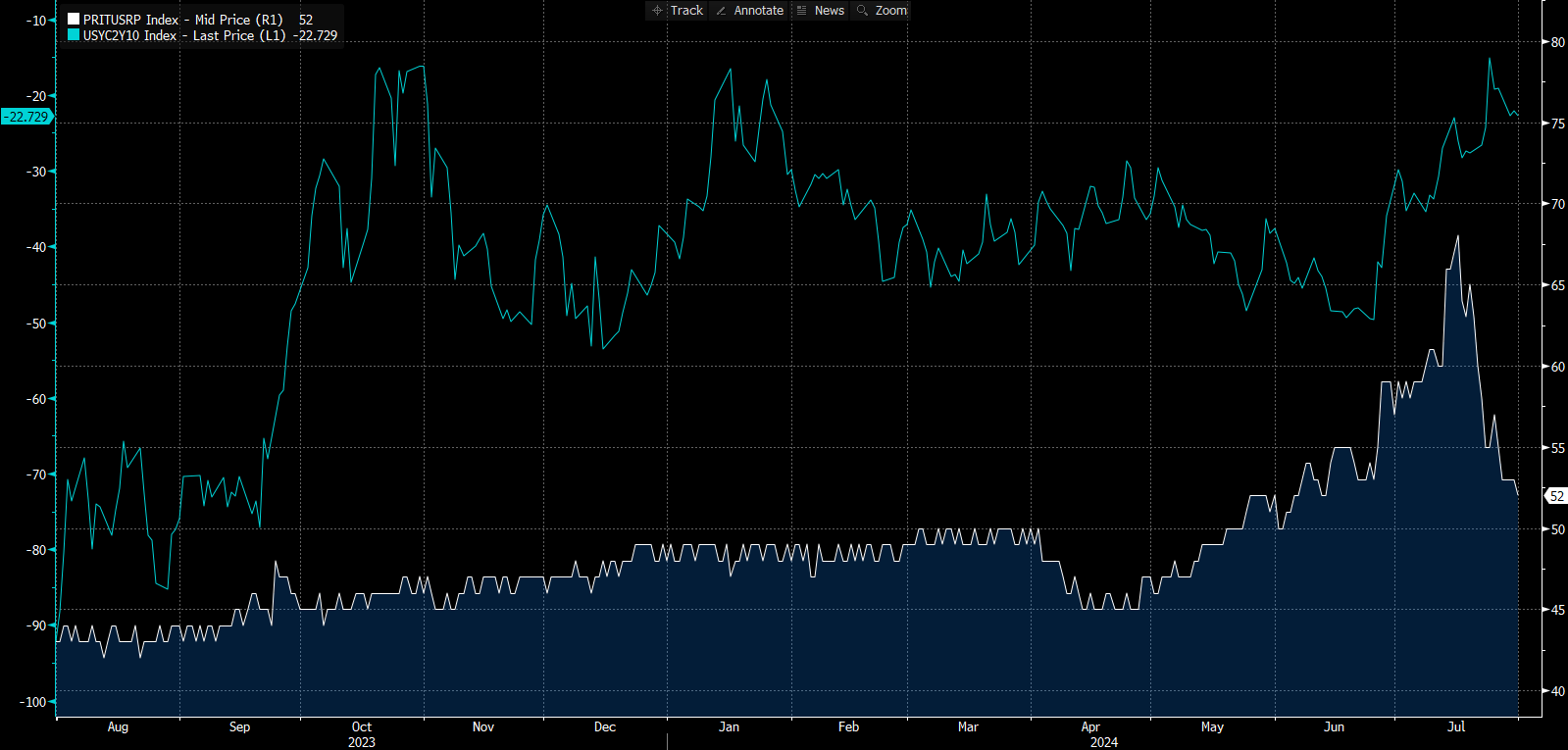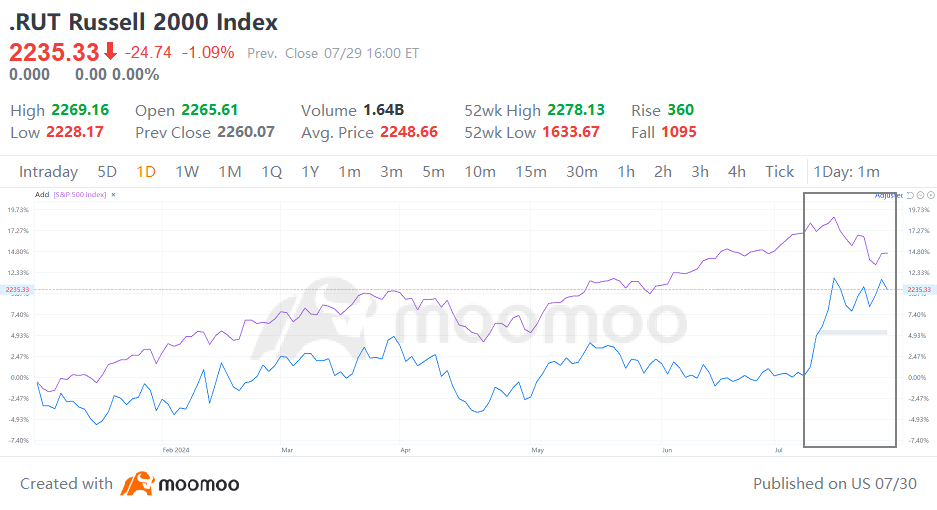The Federal Reserve is expected to reveal its interest rate decision for July at 2:00 PM Eastern Time. Global markets are closely watching this announcement as it is anticipated that the Fed may signal the possibility of a rate cut. According to the CME FedWatch Tool, the market is predicting an 100% chance of a rate cut in September, with a total of three rate cuts expected for the year.
Kate Moore, head of thematic strategy at BlackRock, said on Monday that Fed officials are now facing difficult decisions and hope to remain cautious, especially before the US election. BlackRock expects the Fed to cut rates in September, possibly three times this year, and then once in the first half of next year, as the firm expects to face more downward pressure on inflation later on.
Assets to Watch
As the Fed rate cut draws near, market trading themes have rotated. Generally speaking, small-cap stocks and biotech companies with high financing needs and sensitivity to interest rates are expected to benefit the most.
Treasury Bond
 The continued rise in rate cut expectations has driven down overall US bond yields. According to Bloomberg data, US Treasuries have risen for three consecutive months, marking the longest rally in three years. The recent surge has pushed up a key indicator of US bonds, the Bloomberg US Treasury Bond Index, up 1.3% this month, and increased its return since the end of April to around 3.9%.
The continued rise in rate cut expectations has driven down overall US bond yields. According to Bloomberg data, US Treasuries have risen for three consecutive months, marking the longest rally in three years. The recent surge has pushed up a key indicator of US bonds, the Bloomberg US Treasury Bond Index, up 1.3% this month, and increased its return since the end of April to around 3.9%.
As of July 30th, $U.S. 2-Year Treasury Notes Yield (US2Y.BD)$, which is more sensitive to monetary policy changes, fell 39.7bps in July, while $U.S. 10-Year Treasury Notes Yield (US10Y.BD)$ declined 25.5 basis points.
Short-term rates mainly reflect changes in rate cut expectations, while the 10-year US bond rate is also affected by Trump's policies. Trump's policies advocate for tax cuts, tariffs on imports, tightening of immigration policies, and boosting domestic manufacturing, which help stimulate domestic demand, increase long-term inflation expectations, and limit the decline in long-term bond yields.
The decline in long-term rates is not as significant as that of short-term rates, and the US bond yield curve is significantly steep. Last Wednesday, affected by safe-haven sentiment, the price of the 2-year US Treasury bond rose, and the yield fell to a more than five-month low. The yield spread between the 2-year and 10-year US Treasury bonds narrowed to 9 bps, the narrowest record since July 2022. The steepening of the US bond yield curve (buying short-term bonds, selling long-term bonds) has become a relatively certain direction for investors.

Considering that long-term treasury bonds have longer durations than short-term government bonds, buying long-term treasury bonds may bring more returns to investors.
UBS Wealth Management published a report that predicts that the 10-year US Treasury bond yield will fall to 3.5% by mid-2025. However, the bank also acknowledges that this view is risky, as the volatility of term premiums will increase due to uncertainty in US elections and the fragile fiscal situation of the US government.
Small-Cap and Biotech Stocks
Small-cap companies generally have higher leverage and are more likely to finance through floating rate debt, making them more sensitive to interest rates compared to large-cap stocks.
In recent weeks, the US stock market has witnessed the "great rotation" with tech stocks, led by the "Mag 7," underperforming while small-caps, led by $Russell 2000 Index (.RUT.US)$, experience a strong rebound. Since July, the Russell 2000, representing small-caps, has risen 9.54%, while $S&P 500 Index (.SPX.US)$ has fallen 0.44%.

Tom Lee, co-founder of Fundstrat and known as the 'Wall Street wizard', stated that if history is any indication, focusing on small-cap stocks may see a growth of 15% or more in August. Lee previously predicted that the rebound of the Russell 2000 index would last about 10 weeks and reach a final increase of 40% beginning in August.
However, some analysts are cautious about small-cap stocks.
Lisa Shalett, Chief Investment Officer at Morgan Stanley Wealth Management, warned against chasing small-cap stocks as their upward trend may not be sustainable. The lagging effects of rate cuts and the large number of unprofitable companies in small-cap stock indices make them lack favorable factors. The profitability issues of this group are unlikely to be resolved by a 75 basis point rate cut. The prospect of a Republican victory in the November election may boost small-cap stocks, but this trend is expected to be short-lived.
In addition, the lower financing costs brought by rate cuts are beneficial to biotech companies that require large R&D investments. The S&P Biotechnology Select Industry Index has risen 6.71% since July and 10.86% year-to-date.
Gold
Earlier this month, $Gold Futures(DEC4) (GCmain.US)$ climbed to a historic high of $2,488. Gold has risen more than 18% this year. The Fed's rate cuts, continued gold purchases by central banks around the world, ad heightened geopolitical tensions have boosted the appeal of gold as a safe-haven asset, pushing up global gold prices.
Analysts at Goldman Sachs released a report stating that China's gold demand is currently showing periodic weakness due to the high price sensitivity of Chinese consumers and recent price surges. However, structural changes have kept China's structural gold demand relatively stable. The report predicts that gold prices will reach $2,700 by 2025, about 11% higher than current gold prices.
In a research report on July 18, Morgan Stanley stated that the support for gold prices in the financial markets is gradually emerging. Against the backdrop of rate cuts boosting gold prices, it is expected that gold prices will rise to $2,650/ounce in the fourth quarter of this year.
For more information about gold, from upstream to midstream and downstream, along with insights on related stocks, check out "Industrial Chain" feature on moomoo>
